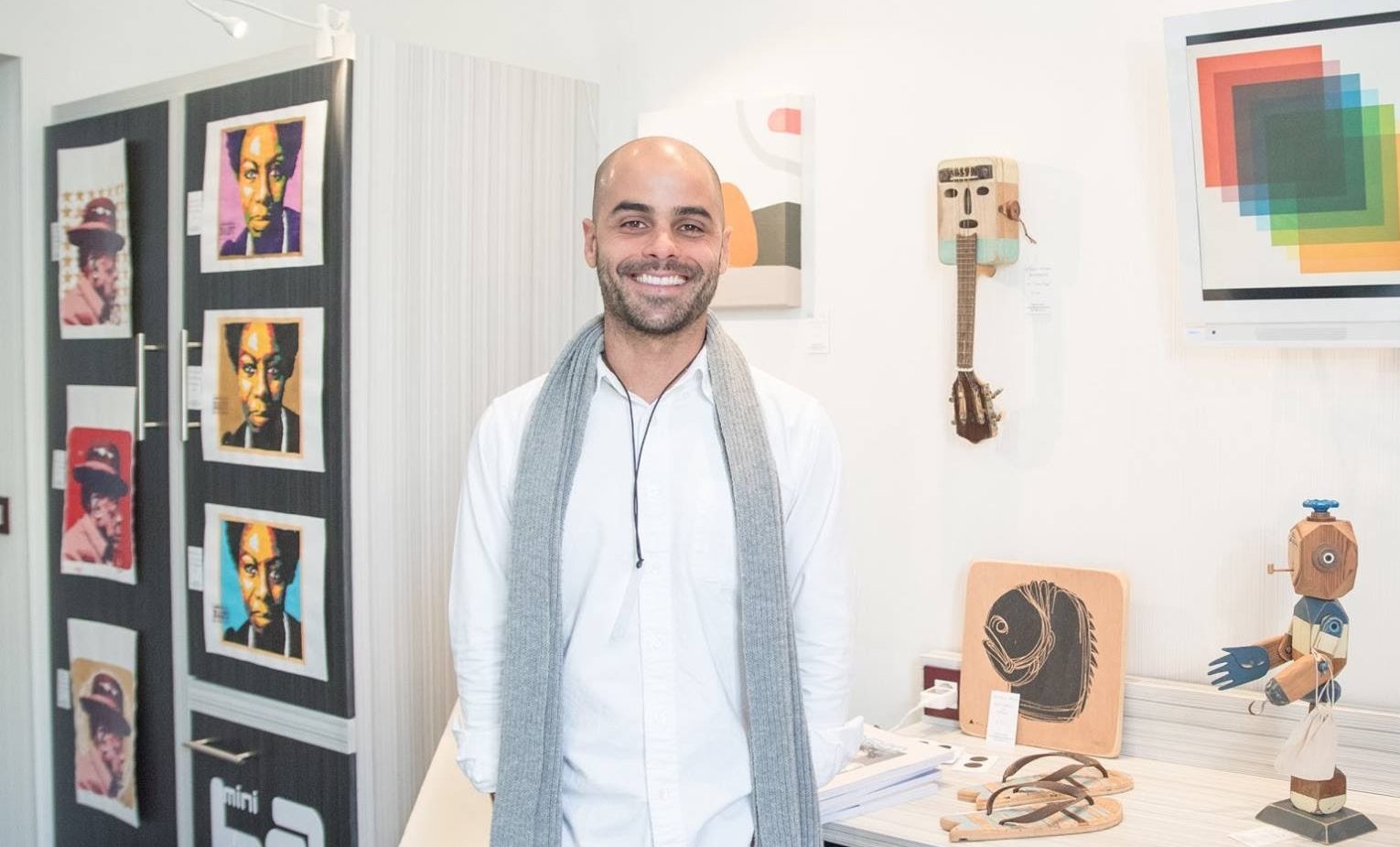Gentrification and high rents have changed Lisbon’s popular district Bairro Alto. Gallery owner Marcelo Duarte still found a way to live his dream with little money.
It is quiet in Bairro Alto. The many bars in the small cobblestone streets are closed. Lisbon’s party tourists from last night are still asleep or sightseeing around the city. A local here and there is looking out of the window. It is early afternoon and Marcelo Duarte is throwing a bucket of dirty water from cleaning his art space into the manhole cover in the middle of the street. White shirt, sleeves stylishly rolled up, khaki pants, beard perfectly shaved. At first sight the 38-year-old looks like a clean-cut modern art dealer.
“Can I come in?” “Sure”.
But once Marcelo shows you his art space “Deslocado” and talks about his recent exhibitions the first impression changes. This man is not in the art world to make money but to learn something about life and human beings. He has a soft voice, pauses when he speaks and when he has found a word he was looking for he ends his sentence with a smile. It seems like it makes him happy when he has found the right words to describe what he loves. For example describing his favorite piece of art in his collection: “It is a raw thing. Strong. Actually a punk thing.”
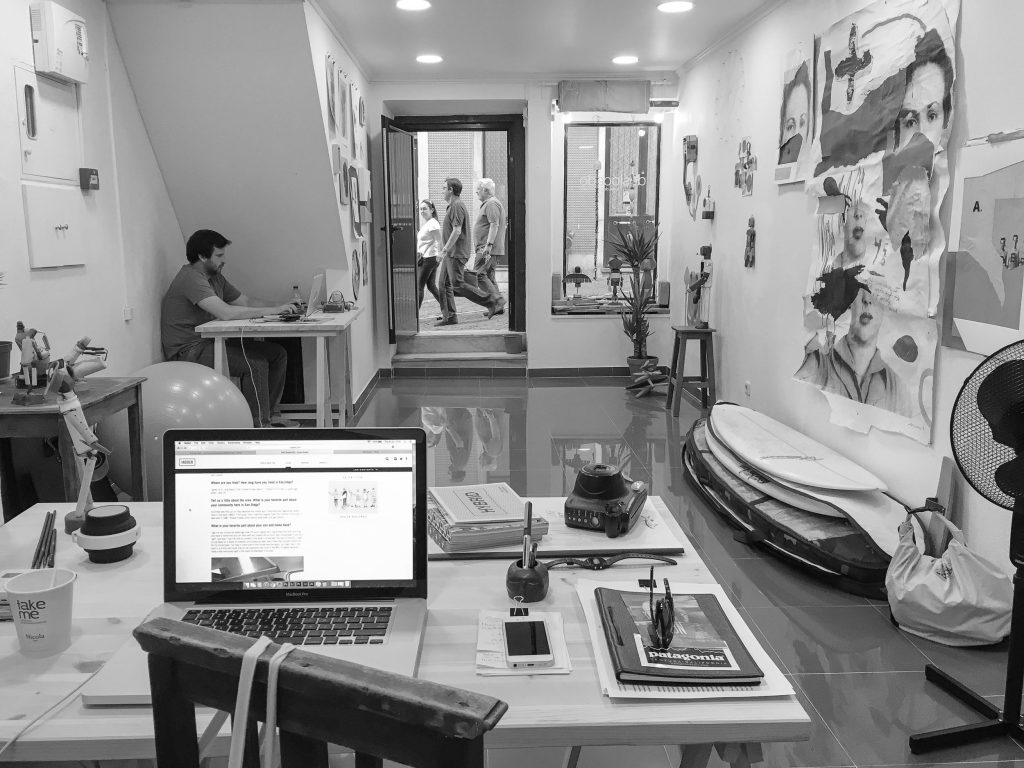 Gallery with a view: Deslocado in the heart of Bairro Alto
Gallery with a view: Deslocado in the heart of Bairro Alto
Bairro Alto is a neighbourhood that has changed quite fast over the last couple of years. Tourists come here for a few days, party, eat, sleep and move on. But Marcelo’s work and his art space “Deslocado” slow down the pace, try to connect below the surface and invite you for a conversation. And Bairro Alto and the city of Lisbon need a conversation. An exchange about how to connect the past with the future, the old and the young, the locals and the tourists, the heart and the money.
You grew up in Rio de Janeiro. How did you end up in Lisbon?
I was married to a Portuguese woman and came with her to Lisbon three years ago. We are not married anymore but I decided to stay. I still have my art gallery “Graphos” in Rio de Janeiro but the art scene here is better than in Brazil. The economic situation in Lisbon is also better and I have dual citizenship. I love Rio but it is a very violent city. Portugal and Europe offer me more opportunities at the moment.
Why did you open up “Deslocado”?
I have a lot of art works here from different artists – mostly from Portugal and Brazil. I did five exhibitions with Portuguese and Brazilian artists and most of them produce their work in Lisbon. I wanted to have a place to show these works, to meet people and to talk about my projects. Then I had the chance to get this space and jumped at the opportunity.
VIDEO: Marcelo shows us around “Deslocado” and Bairro Alto
Why is it called “Deslocado”?
“Deslocado” was the name of an exhibition I did two years ago at the Centro Hospitalar Psiquiátrico de Lisboa. It was quite a big one with about 15 artists. I liked the name. It names a place but at the same time it is more than a place. “Deslocado” is a human experience.
What is this human experience like?
It is about a group of people working together. It is a project based on several exhibitions with artists who are also friends of mine. They all do different work and have different approaches. It is about sharing ideas, connecting and exchanging. The work experience is quite different when you work with other people rather than alone. This is what “Deslocado” is about.
In the last five years Marcelo has put together five exhibitions in Lisbon and Rio de Janeiro. Some of them like “Matilha” (Pack of Wolves) and “Deslocado” (Displaced) with more than ten different artists. A challenge if you have ever tried to cook a diner with more than three people in the kitchen. But for the 38-year-old it is a driving force of his work. “I need people. To me working with many people is”, he is looking for the right word, “rich”, he says after a short pause. A friend of his who is doing work as a graphic designer at the art space adds to the conversation: “It is a mess!” Laughter. “A rich mess”, everyone agrees in the end. A rich mess also holds true for the transformation of Lisbon during the last couple of years.
 A rich mess: Piece of work from the exhibition “Matilha” curated by Marcelo
A rich mess: Piece of work from the exhibition “Matilha” curated by Marcelo
On your business card it says, „Deslocado – This is not an art gallery“. What do you mean by that?
I don’t like traditional art galleries and the art market. I am not interested in the mainstream, marketing and selling. I think about art as freedom. Of course Deslocado is an art gallery in a certain sense. But at the same time it is not. Do you know what I mean?
Yes, I can see it right here. Did you look for a space particularly in Bairro Alto?
Yes, I chose it on purpose. In this neighbourhood you have a lot of people with different nationalities. It is a very creative area. The Teatro do Bairro is right here and the Galeria Zé dos Bois, an art space and music venue, is around the corner. I need people around me and Bairro Alto is home to a lot of good people. To me the Bairro Alto and Baixa neigborhoods are Lisbon. You have a very good atmosphere here.
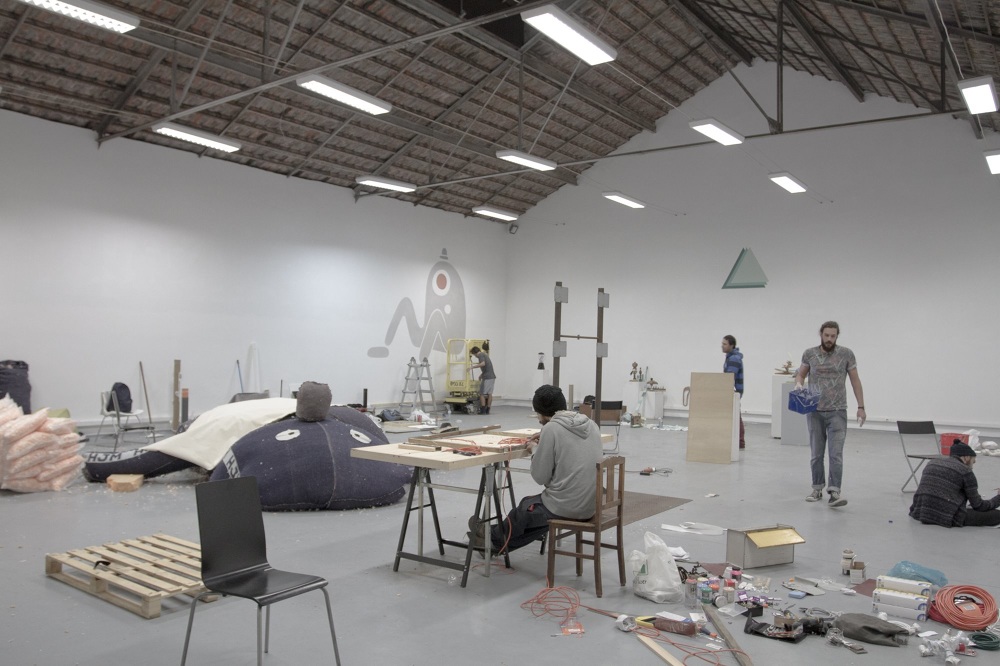 “Deslocado” exhibition at the Centro Hospitalar Psiquiátrico de Lisboa
“Deslocado” exhibition at the Centro Hospitalar Psiquiátrico de Lisboa
But some people say Bairro Alto has lost its bohemian charm because of the many tourists.
This is true to a large degree. Lisbon at the moment is for tourists. People come and spent money. But they mostly spent it on shopping and partying. There are a lot of new shops, restaurants and hostels for tourists. But the money does not reach everybody. Especially for the arts it is not easy. Also the prizes for rent have gone up very fast because there are a lot of Airbnb places here. There is definitely a huge gentrification going on. Despite that, this is still my favorite neighborhood.
Rumour has it that annoyed locals in Bairro Alto (Old district) sometimes throw buckets of water at noisy tourists in the streets. In the 20th century many artists, intellectuals and writers have moved here and made this part of the city a bohemian hotspot. But in the last ten years the district has become more and more crowded with tourists looking for a good night out. The number of Airbnb apartments has skyrocketed while at the same time the rent has become more and more expensive. The consequence: Especially younger folks move out of the neighbourhood or out of the city into the larger Metropolitan Area. “Three years ago the rent was half of what it is now”, says Marcelo’s graphic designer friend. “A friend of mine rented a rather small apartment for 800 euros three years ago. That is a bargain now”, he adds. And when Madonna even moves to Lisbon you know rent prices will not slow down any time soon.
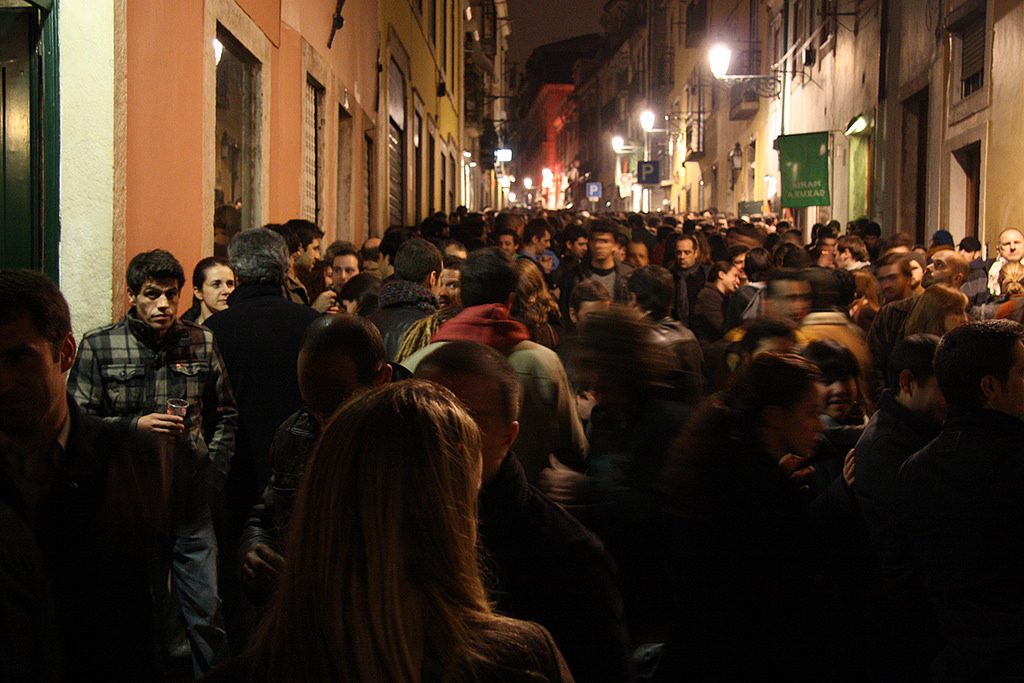 A party night out in Bairro Alto (c) Wikimedia Commons
A party night out in Bairro Alto (c) Wikimedia Commons
What is your role in “Deslocado”?
I am the curator and observer. My job is to bring people together and to make things happen. I am not an art dealer. I hate art dealers. I make money with production and curating. I don’t like to sell. It doesn’t give me pleasure. I know it is strange because I have an art gallery.
What are you looking for in the artists you work with?
I cannot really explain it. It is more like a feeling. I am looking for something raw, something outside, something true. A punk thing. I work together with emerging artists because the big galleries don’t show young artists. I want to help that scene, as younger artists don’t have many spaces to exhibit.
How hard is it to survive as an artist in Lisbon?
It is difficult to be an artist everywhere; Lisbon is no exception. Rather the contrary as the market is quite sceptical towards young artists. To make exhibitions is not that hard. The problem is to sell. Portugal has a minimum wage of 650 Euros per month and even architects or engineers often do not earn more than 1000 Euros per month. Therefore it is not easy to afford art and support emerging artists. My artists also work as designers and do other jobs. We have a huge contradiction here. People need to sell their works to earn money. But if you think too much about selling your work loses its edge.
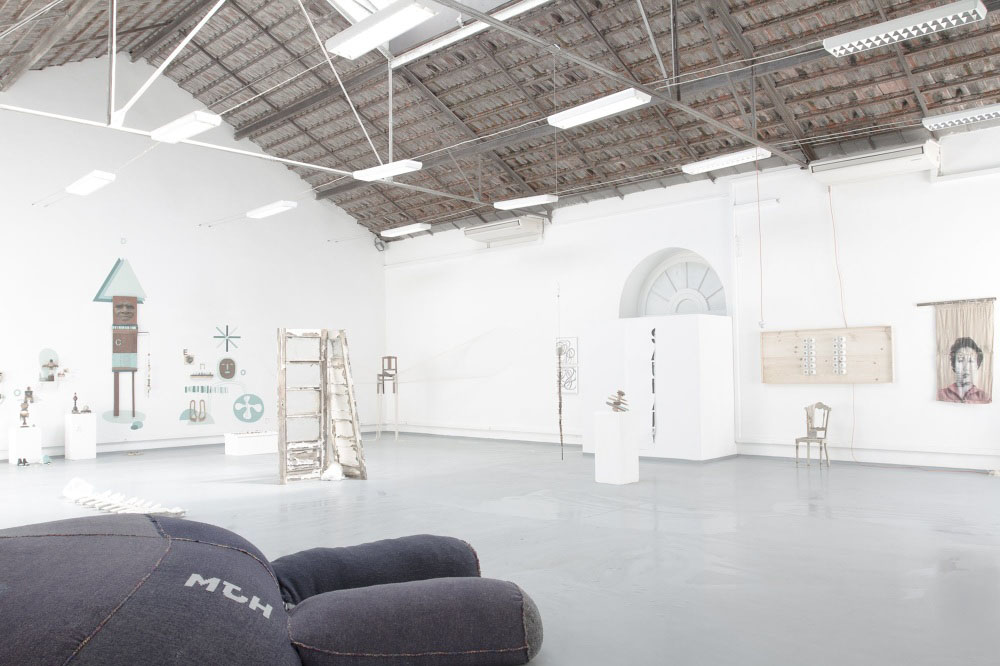 Artists work together with patients from the psychiatry: “Deslocado” exhibition
Artists work together with patients from the psychiatry: “Deslocado” exhibition
Besides his work as a curator, Marcelo earns his money as a photographer. But to make a decent living is still hard. His art space costs 750 Euros per month. It is his work place and home at the same time. He works, eats and sleeps at “Deslocado”. To afford the rent for his art space and rent an apartment for himself would cost too much money. So when the evening comes and the tourists take over the district Marcelo gets out a mattress for the night and goes to bed. Sometimes before he calls it a day he goes for a good night beer at the bar next door. He does not complain as he can do what he loves and supports the art he cares about. “This is everything I have at this moment in my life,” he says. And here it is again, the smile at the end of a sentence.
The Deslocado exhibition at the Centro Hospitalar Psiquiátrico de Lisboa was quite unique. Tell me more about it.
I really enjoyed this exhibition. It took place at the Psychiatry Hospital, which is like a small city with several pavilions. One for example is for theatre plays and one for art projects. The idea is that well known artists work together with patients from the psychiatry. Everybody involved in our exhibition produced his or her art works at the pavilion. It was an amazing experience for me. Anabela Soares was also part of the exhibition. She is a patient and artist who for example worked with Emir Kusturica at the hospital. Her work is what I call the true thing. You know, she is not able to make art for the market. She just does her own thing.
What’s up next?
I am currently planning an exhibition with a woman and a man. Hopefully it is going to happen within the next couple of months. I might do it at my space, but if the group grows I will probably look for a larger space.
Marcelo Duarte was born in 1978 and works as a curator, art producer and photographer in Lisbon and Rio de Janeiro. Besides “Deslocado” he runs the art space “Graphos” in Rio de Janeiro.
Right in the heart of Bairro Alto: Deslocado
The distric and the city: Bairro Alto and Lisbon
Portugal’s capital has moved up the ladder of places to be very fast in the last couple of years. CNN even asks if Lisbon is the coolest capital in Europe. And there are good reasons for that: The city with a rather small population of 550,000 has a unique charm with old neighborhoods, good food, lots of sun, art and bars. Compared to places like London, Paris or Copenhagen the city is cheap and less stressful. Hit by the financial crisis Lisbon has worked itself out of hardship with start-ups, small businesses, restaurants, shops and tourist programmes popping up almost on a daily basis. Slowly young educated people who have left the city and moved abroad during the crisis in search for work are coming back to Lisbon.
But along with the upswing came gentrification, reals estate investors, rising rents, precarious working conditions and a city development that seems more interested in tourists than the local population. Bairro Alto is a good example for this development. But despite the packed tram line number 28, many Airbnb apartments, cheap bars and crowded viewing points in the city there are also alternative ways to explore Lisbon. A good example is the “We Hate Tourism Tours” offering a different insight into the city. And this is just the beginning of a conversation about the direction of Portugal’s capital. Representative for this conversation is also a recent neighborhood development project in the district of Mouraria asking the question of how to find the right balance between tourism and the needs of the local population.
The country: Portugal
Portugal with a population of about 10 million was one of the European countries hit the hardest by the financial crisis of 2008. But due to controversial political reforms and a focus on tourism Portugal is considered to have mastered the crisis rather well. Still: According to the Lisbon-based Emigration Observatory, Portugal ranks second after Malta among the European countries losing more population to emigration. An average of 110,000 Portuguese per year have left the country between 2013 and 2015. A the same time Portugal experiences a huge increase of foreign tourists. In 2016 the record number of 11.4 million tourists stayed in Portuguese hotels.
